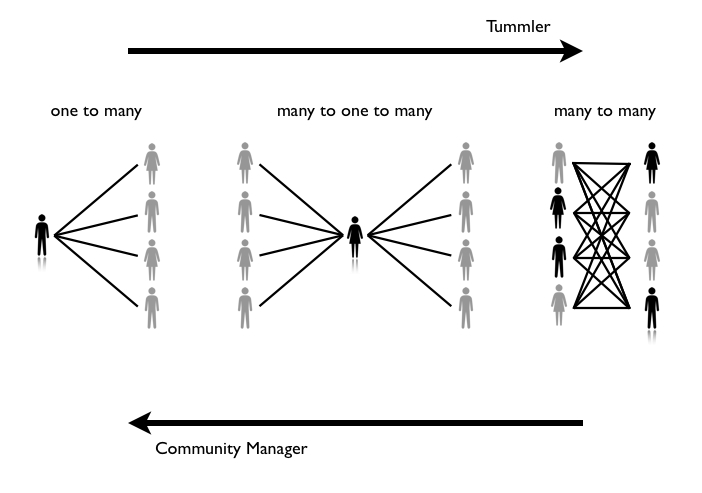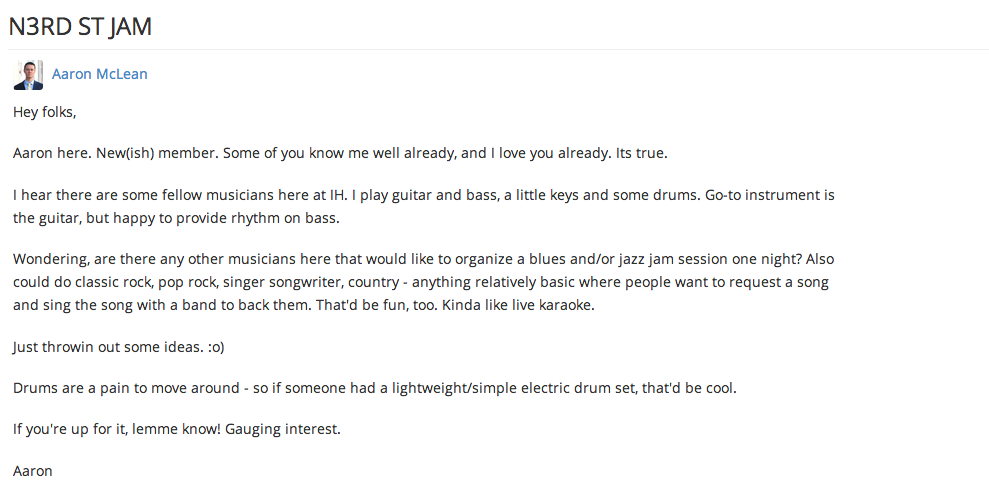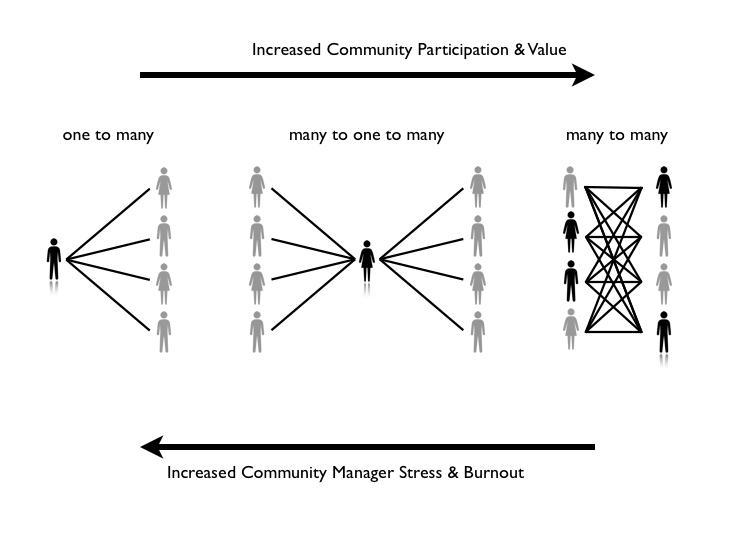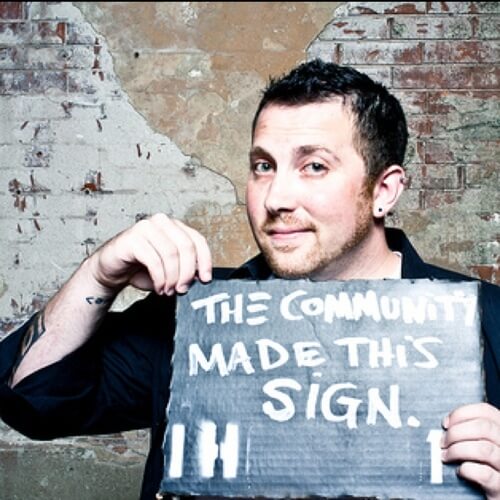I can’t stand the title “community manager“. I’m not a community manager. I never have not never will hire a community manager.
And I know I’m not the only one.
I’ve been thinking hard about these silly two words, and one realization is that my problem isn’t exactly with the term itself.
Rather, the problem is a mindset that all-too-often goes along with becoming a manager.
Just hearing the word “manager” suggests a hierarchy and a control which is unnatural in communities (and truthfully, it’s even unnatural in companies).
So today, I want to talk about one particular manager mindset, what’s wrong with it, and introduce an alternative mindset for people in community-manager-like roles.
But first, a story.
Late last year, I was chatting with one coworking space’s community manager over a coffee. We were talking about the ups and downs she’s gone through with her coworking space’s members. As usual, I noticed some patterns in what she’d told me, and pointed a few of them out.
At the end of our conversation I asked her, “What’s one thing you’re taking away from this conversation? What’s one thing you going to do differently moving forward?”
“I do too much for them”, she replied.
There was a mix of frustration and relief in her voice, her eyes, and her posture.
She went on to explain all of the things she does on a daily basis for her community members. From organizing daily activities to making sure their coffees are warm and full, she was spending a tremendous amount of her time and energy doing things for the members of her community.
Before our conversation, she saw all of that work as part of helping community members feel warmly welcomed and comfortable. Suddenly, she saw that every time she filled up someone’s coffee for them, she was actually contributing to a major weakness in her community.
The Problem with Cruise Director Mindset (CDM)
My community manager friend was doing what she thought was best for her community, but she approached her work with the Cruise Director Mindset.
One common quality of cruise directors is their enthusiasm and excitement. They use that excitement to get the cruise guests excited. The cruise director organizes activities so people can socialize, and announces them over the loudspeaker – and at each meal – so that guests know what things they can participate in.
Cruise directors often go above and beyond the call of duty to do nice things for people, making guests feel special.
Sounds like great person to have around, right? Well, there’s just one problem.
The Cruise Director is a dependency, a single point of failure. And Cruise Director Mindset – CDM – turns community managers into similar single points of failure.
Think about it this way: when the cruise director starts tapping the tambourine against their hip, and calling into the microphone for people come to join them on the dance floor, some people will inevitably oblige. But what happens if the cruise director didn’t show up one day?
SCREEEEEEEECH. Except for that older couple who are two-stepping no matter what genre of music is playing, that dance floor is e-m-p-t-y.
This should remind you of the “culture” in an organization that only happens when certain people are in the room. This should also remind you of my community manager friend’s realization that she does too much for her members.
Rather than think of culture as a “warm, fuzzy feeling” (even though that’s how your community members are most likely to describe it) I’ve learned to think of culture as a system designed for action and reinforced interactions between people.
The dirty little secret is that you can’t create the culture, you can only create the system.
Culture is the result of continual, but small actions – and interactions – between many people. The best thing you can do is to create a system that helps a particular culture grow, even when you’re not in the room.
CDM not only introduces a single point of failure into the system, it makes it harder for members to see themselves as users – maybe even as owners – of the system.
This is why I think “community manager” is one of the worst possible names for the role.
Now, I don’t like suggesting that we should kill off the term “community manager” without proposing a better name. Well…..it turns out it’s pretty tough to come up with a new term that’s not just a derivative of “community manager.” Here are a few that I’ve heard more than once over the last 8 years of working with the global coworking community:
- Community facilitator
- Community cultivator
- Community catalyst
- Community activator
…among others
But in 100% of my experience, the more people use these derivative terms to avoid saying “community manager”, the more often we hear,
“oh, is that like a community manager?”
And now we’re back at square one, with all of the expectations that come with it.
So I’ve been wanting for a term that doesn’t come with that baggage or association. A word that has roots in the real world, but is generally unknown to people who already “know” what community management is.
WTF is a Tummler?
To the Google, which says:

If you’ve read this far, I bet you thought something like this when you saw the definition:
“That’s it? That’s what I’ve been waiting for? Come on, Alex. That definition sounds like a cruise director, and you just went on and on and on about how acting like a cruise director is a kiss of death!”
On the surface, yes, the roles are similar. Which is precisely why Tummler is the perfect replacement term for Community Manager.
Because remember, this isn’t about re-keying a term. It’s about having a more effective mindset when working with your community. And that’s where the difference starts to emerge.
While a Tummler has the same objective – to encourage people participating in the dance floor – Tummlers take a very particular approach to “warm” the crowd.
They cruise the party. They listen, and they observe. They ask questions, and they earn trust.
They meet people at the edges of the crowd, connect with them, and then slowly help those people discover their own way into the mix.
Like a human KitchenAid fitted with a special invisible paddle designed for coaxing empathy out of almost anyone, a Tummler stirs, blends, & incorporates the people they encounter with each other.
And a Tummler actively seek to stay out of the spotlight for more than a few minutes at a time, or however long is actually necessary.
Here’s a drawing that I made to help illustrate the difference between a group who is connected by a community manager, vs one who is connected by a Tummler.

What are those lines between the people supposed to represent?
I asked that question to my newsletter readers two weeks ago, and I got great answers from many of them, including:
- expertise
- directing
- relationships
- intentions/goals
The answer that nobody gave, though, was value.
Who delivers the value in your community?
Check out this blog post from actual cruise director Ken Rush. In particular, this quote:
‘People also ask me, “What is the toughest part of your job?” and my answer is “To try and make every single person onboard happy.”
I believe that Ken is sincere, and based on the schedule alone, is clearly someone who works hard for his guests. But look at that goal:
“…to try and make every single person onboard happy.”
Even if you’re not working 18 hour days, 7 days a week like Ken, do YOU work like it’s YOUR job to make every single person in your community or organization happy?
This mindset doesn’t scale. But does it have to?
The most obvious problem with the “one to many” approach of Cruise Director Mindset is that you – in spite of your best attempts and all of the best tools – don’t scale very well.
But in small communities and even teams, does that really matter?
As Scott Berkun points to in his teardown of a recent post by AirBnB CEO Brian Chesky about their company’s culture:
“…there is a presumption among many executives that culture is an asset created and managed like technological resources, which is a mistake.“
Any culture – good or bad – is the result of many small and consistent actions and interactions between many people. Everybody can benefit, and everybody can contribute.
It’s your job to help community members understand that everyone shares that responsibility for culture.
So, let’s take a peek into the mind of a Tummler.
Two weeks ago, a message went out to Indy Hall’s GroupBuzz list (our community listserv):

And within a couple of hours, this happened:

By the end of the day, the conversation had two dozen replies, and nearly as many likes.

And there are a few subtle things that would be tough to notice from the outside:
- This thread included a mix of new members, like Aaron, as well as people who have been members for a long time
- Several of those people had never replied to a single thread on the listserv before and,
- To my knowledge, none of these people have ever played music together before
A week later, Aaron came back to the the community.

And just like that, a group of strangers serendipitously formed a jam band.
If you ask most veteran members of Indy Hall, they’ll tell you this thing is a pretty normal thing in our community. It’s how we launched a Farmers Market. It’s how companies form, and grow. It’s how every Indy Hall Arts Show begins and ends. It’s even how a street in Philadelphia got it’s name.
If it happened once, you might call it magic. If it happened a second time, you might call it a trend.
But in our community, it happens all the damn time. Why?
There are Tummlers in our midst
Say hi to Karina. If you visit or join Indy Hall, you probably won’t have a choice but to say hi to Karina. She’s one of our core team members, a critical part of the tiny staff that helps run our 300 person organization.
And Karina is one hell of a Tummler. To see how Tummling works, let’s rewind the clock to a conversation that Karina had with Aaron the morning before he sent that first email.
Step 1 – Get curious, and stay curious.
A Tummler makes it their job to be genuinely curious about the people they interact with on a daily basis. Not just the new people because you want them to feel welcomed…everybody.
Be prepared to welcome discoveries and surprises. When you approach people assuming nothing, you’ll be amazed by what you can learn learn about them.
After all, just because you know something thing about a person doesn’t mean you know everything about that person.
Aaron had already been a member for almost 3 months, but on the morning before he started that thread, Karina noticed he was carrying a guitar case. She had never talked to Aaron about music before, or the fact that he played an instrument.
So she started asking questions:</p>
Karina: “Oh you play guitar?”
Aaron: “Yes, I dabble.”
Karina: “Do you play in a band or anything?”
Aaron: ” I used to jam and I miss it.”
Step 2 – Notice patterns. Patterns are opportunities to instigate.
The more people you approach with curiosity, the more patterns you’ll begin to notice.
Patterns for what people have in common. Patterns for what people don’t have in common. Patterns in the questions people ask, in the things that people are excited about, and in the problems people are trying to solve.
Being able to notice these patterns is where the magic begins to happen.
Think about it this way: almost everybody (including you!) knows the painful struggle that comes with trying to get a group of people on the same page about…well, about anything, really.
It sucks. Nobody likes being on the receiving end of a hard sell. It’s an impossible environment for getting any kind of work done, and it’s an dead end for building any kind of trusting relationships.
Instead, take notice of when people might already be on the same page about something.
Karina knew that a bunch of other members play instruments, too. How? Because she stays curious with everybody.
Karina: “There are a couple of members here that play too!
Have you met Donnie? He sits upstairs by the windows.”
Aaron: “Oh yeah?
Step 3 – Give other people permission participate.
This is the Tummler’s most elegant finishing move.
After noticing Aaron’s guitar, and realizing the common theme among Indy Hall members who play instruments, Karina went in for the kill:
Karina: “OH! You should post to GroupBuzz, our community list.
That would be a great way to reach out to Donnie and other people.
Can I come when you guys jam? I’ll bring the wine!”
Aaron: ” I don’t know how to do that, can you do it?”
At this point, if Karina had a CDM, she would’ve posted something to the list about how she had just found out that Aaron played guitar and was looking for people to jam with.
But instead, she Tummled:
Karina: “I post announcements all the time, people are probably sick of hearing me talk…but you should do it! You did you get your invite to GroupBuzz, right? This would be a good way to introduce yourself to people in the community who don’t know you yet.”
Doubling down on her suggestion to connect with other members, Karina actively kept herself out of the driver’s seat and urged Aaron to own his own introduction.
Which he posted later that day.
Don’t forget, this is about value.

The thing to remember about communities (unlike nearly every other business exchange): the majority of the value your members can get from being a part of your community is from each others’ participation.
Let me say that again in a different way: the number one reason to be a part of any community is the community members themselves. And unlike business transactions, where it’s the responsibility of a single person or entity to create the value to its customers, it’s the members of the community who create the majority of the value to each other.
It’s your job to show community members that everyone shares that responsibility for culture.
Which is why you need to be more like a Tummler, and less like a cruise director.
P.S. A Few Credits and Thanks
I’m hardly the first to suggest this shift in language & mindset, but I believe that previous attempts were simply ahead of their time, and we need this conversation now more than ever before.
Chris Messina and Tara Hunt earn the credit for being two of my earliest inspirations for what was possible with communities. Working with them in the beginning of my career opened my eyes to much of what was possible, and reinforced many ways that I felt that business should be able to be done. They exposed me to books like The Starfish and the Spider, and Small Pieces Loosely Joined, and helped me experiment in the real world by introducing both Barcamp and Coworking as concepts that would spread worldwide, and irreversibly connect me to the world in a very different way.
It was through that new world that I found Heather Gold, Deb Schultz, and Kevin Marks, and their sadly since-defunct Tummelvision.tv show. These three (and many of their guests over 100ish episodes) were pre-eminent thinkers who worked to understand the “open web” before the world learned to call it “social media”.
While your efforts to popularize these terms may have been ahead of their time, I cannot extend enough gratitude to all of you for the lessons you shared. They’ve shaped me and my practice, my community, and my team.
And we’re not even close to done yet.
 I am always thinking about the intersection of people, relationships, trust and business. I founded
I am always thinking about the intersection of people, relationships, trust and business. I founded